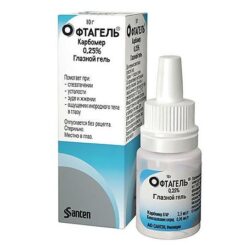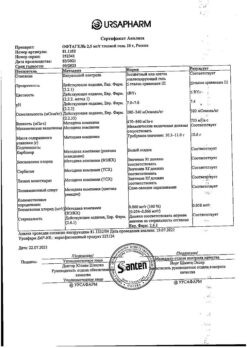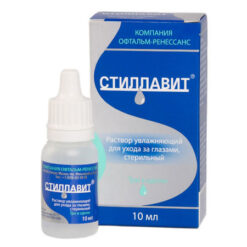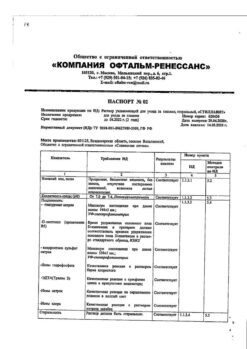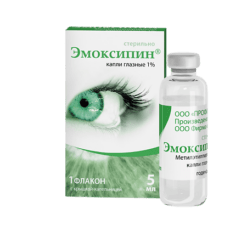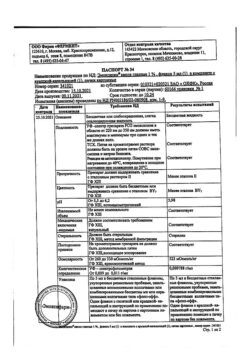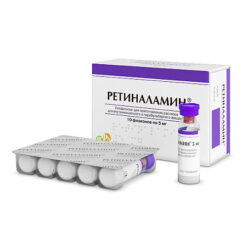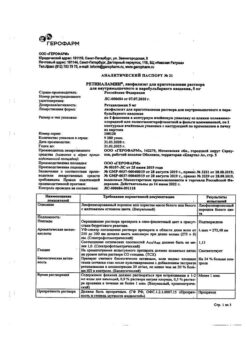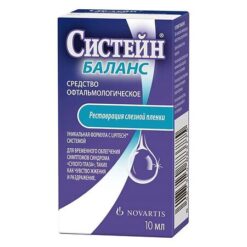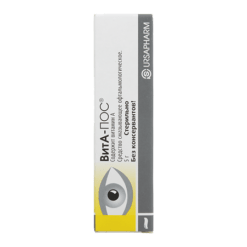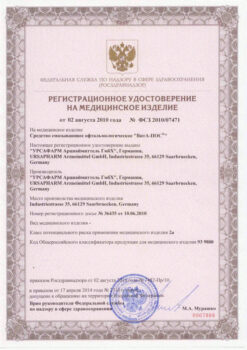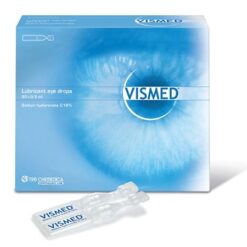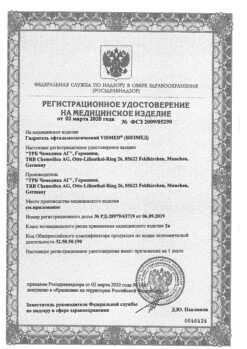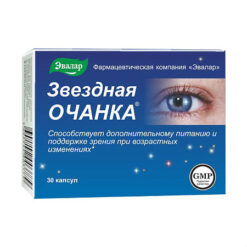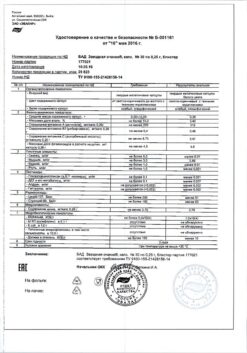No products in the cart.
Oftavix, eye drops 0.5% 5 ml
€6.75 €5.91
Description
A broad spectrum antimicrobial from the group of fluoroquinolones for use in ophthalmology. It has a bactericidal effect on streptococci and staphylococci (including penicillin resistant), Klebsiella, E. coli, diphtheria corynebacterium, mycobacteria (including tuberculosis), hemophilus bacteria (including ampicillin resistant), mycoplasmas, chlamydia, gonococcus, clostridia etc.
Levofloxacin is the L-isomer of the racemic medicinal substance ofloxacin. The antibacterial activity of ofloxacin refers mainly to the L-isomer. Levofloxacin blocks DNA-gyrease and topoisomerase IV, disrupts superspiralization and cross-linking of DNA breaks, inhibits DNA synthesis and causes deep morphological changes in cytoplasm, cell wall and membranes.
Pharmacokinetics
Levofloxacin persists well in the tear film after instillation into the eye. In studies on healthy volunteers, mean concentrations of levofloxacin in the tear film measured 4 and 6 hours after topical administration were 17.0 mcg/mL and 6.6 mcg/mL, respectively. Five of the six subjects had levofloxacin concentrations of 2 μg/mL or higher 4 h after instillation. In four of the six subjects this concentration was maintained 6 hours after instillation.
The mean concentration of levofloxacin with use of Oftavix eye drops in aqueous humor was statistically significantly (p=0.0008) higher than the mean concentration of ofloxacin (1139.9 ± 717.1 ng/mL and 621.7 ± 368.7 ng/mL, respectively). Mean plasma concentrations of levofloxacin 1 h after administration range from 0.86 ng/mL to 2.05 ng/mL.
The plasma Cmax of levofloxacin equal to 2.25 ng/ml was detected on the fourth day after 2 days of using the drug every 2 hours up to 8 times/day. The Cmax of levofloxacin reached on the fifteenth day was more than 1,000 times lower than the concentration observed after oral administration of standard doses of levofloxacin.
Indications
Indications
Oftaquix eye drops are used for the local treatment of inflammatory eye diseases in adults and children over 12 months caused by pathogenic microorganisms sensitive to the action of levofloxacin.
For the prevention of complications after surgical and laser operations on the eye.
Pharmacological effect
Pharmacological effect
A broad-spectrum antimicrobial drug from the group of fluoroquinolones for use in ophthalmology. It has a bactericidal effect on streptococci and staphylococci (including those resistant to penicillin), Klebsiella, E. coli, Corynebacterium diphtheria, mycobacteria (including tuberculosis), hemophilus bacteria (including ampicillin-resistant), mycoplasma, chlamydia, gonococci, clostridia, etc.
Levofloxacin is the L-isomer of the racemic drug substance ofloxacin. The antibacterial activity of ofloxacin relates mainly to the L-isomer. Levofloxacin blocks DNA gyrase and topoisomerase IV, disrupts supercoiling and cross-linking of DNA breaks, suppresses DNA synthesis, and causes profound morphological changes in the cytoplasm, cell wall and membranes.
Pharmacokinetics
After instillation into the eye, levofloxacin is well preserved in the tear film. In studies on healthy volunteers, the mean concentrations of levofloxacin in the tear film measured 4 and 6 hours after topical application were 17.0 mcg/ml and 6.6 mcg/ml, respectively. In five of six subjects, levofloxacin concentrations were 2 μg/ml or higher 4 hours after instillation. In four out of six subjects, this concentration remained 6 hours after instillation.
The average concentration of levofloxacin when using Oftaquix eye drops in aqueous humor is statistically significantly (p = 0.0008) higher than the average concentration of ofloxacin (1139.9 ± 717.1 ng/ml and 621.7 ± 368.7 ng/ml, respectively). The average concentration of levofloxacin in blood plasma 1 hour after administration is from 0.86 ng/ml to 2.05 ng/ml.
Cmax of levofloxacin in plasma equal to 2.25 ng/ml was detected on the fourth day after 2 days of using the drug every 2 hours up to 8 times a day. The Cmax of levofloxacin achieved on the fifteenth day was more than 1000 times lower than the concentration observed after oral administration of standard doses of levofloxacin.
Special instructions
Special instructions
When using other ophthalmic agents simultaneously, the interval between instillations should be at least 15 minutes.
The solution cannot be injected under the conjunctiva and into the anterior chamber of the eye. Due to the risk of developing superinfection and fungal infection, the drug is not recommended for long-term use.
Patients with eye inflammation should not use contact lenses.
Due to the content of benzalkonium chloride drops as a preservative, symptoms of eye irritation may occur.
Immediately after instillation, a temporary deterioration in vision is possible, so you should wait before performing work that requires increased attention.
Active ingredient
Active ingredient
Levofloxacin
Composition
Composition
Active ingredient:
Levofloxacin hemihydrate 5.12 mg, which is equivalent to levofloxacin 5.0 mg.
Excipients:
Benzalkonium chloride;
Sodium chloride;
Hydrochloric acid;
Sodium hydroxide;
Water for injections.
Pregnancy
Pregnancy
Contraindicated.
Contraindications
Contraindications
Hypersensitivity to any of the components of Oftaquix or to other quinolones.
Contraindicated during pregnancy and breastfeeding.
Side Effects
Side Effects
Often (1-10%): burning sensation in the eye, decreased visual acuity, appearance of mucous strands.
Rarely (0.1-1%): blepharitis, chemosis, papillary growths on the conjunctiva, swelling of the eyelids, discomfort in the eye, itching in the eye, pain in the eye, conjunctival hyperemia, the appearance of follicles on the conjunctiva, dry eye syndrome, erythema of the eyelids, eye irritation, contact dermatitis, photophobia and allergic reactions.
Other: during clinical trials – headache, rhin
Interaction
Interaction
No specific interaction studies have been conducted with Oftaquix eye drops, 5 mg/ml.
Since the maximum plasma concentration of levofloxacin after topical application to the eye is at least 1000 times lower than after standard oral doses, interactions with other drugs characteristic of systemic use are likely to be clinically insignificant.
Overdose
Overdose
The total amount of levofloxacin contained in one vial of eye drops is too small to cause toxic reactions, even after accidental ingestion. After topical application of an excess dose of Oftaquix eye drops, 5 mg/ml, the eye should be rinsed with clean (tap) water at room temperature.
Storage conditions
Storage conditions
At a temperature not exceeding 25 °C
Shelf life
Shelf life
3 years
Manufacturer
Manufacturer
NextPharma, Finland
Additional information
| Shelf life | 3 years |
|---|---|
| Conditions of storage | At a temperature not exceeding 25 °C |
| Manufacturer | NextPharma, Finland |
| Medication form | eye drops |
| Brand | NextPharma |
Related products
Buy Oftavix, eye drops 0.5% 5 ml with delivery to USA, UK, Europe and over 120 other countries.


